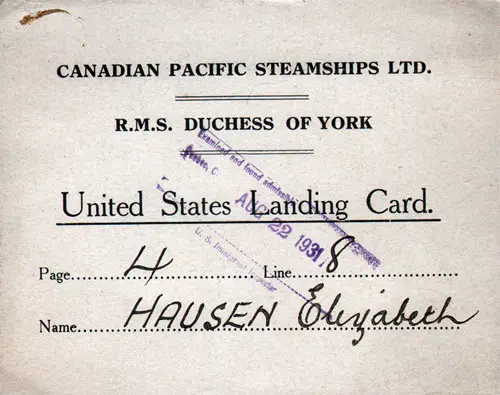RMS Duchess of York Landing Card - 1931

United States Landing Card Issued to Elizabeth Hausen Traveling on Canadian Pacific Steamship RMS Duchess of York, Examined and Found Admissible by US Immigration Inspector on 22 August 1931. GGA Image ID # 1fbbb84072
Canadian Pacific Steamships, Ltd.
RMS Duchess of York
United States Landing Card
Page 4, Line 8 [of passenger manifest]
Name: HAUSEN Elizabeth (or Eliziabeth)
History of the Landing Card as it pertains to the Port of Liverpool.
Inspection of Emigrants at Liverpool
In Liverpool, the embarkation system of passengers differs from that prevailing at nearly every other port, this difference arising from the remarkable rise and fall of tide (over 30 feet). All ships take their cargo in enclosed docks.
When the steerage passengers get on the ship, they must undergo an actual examination by the Board of Trade medical inspector and the ship's surgeon. They are mustered on deck and made to pass between the two doctors. Every emigrant is examined personally and individually.
The object of the Board of Trade official is to reject those persons who are prohibited from sailing under British law from a British port. This is primarily for the protection of the ship and of the passengers, as well as of the crew (who also are examined), and is, in an official sense, apart from consideration of the laws of the United States upon the subject.
The ship's surgeon is expected to look sharply after those cases that come within the prohibition of the laws of the United States. He has to go further than the official purview of the British Board of Trade examiner.
But, by force of circumstances and from a developed desire to avoid any friction and to facilitate and aid the shipping companies in their business, the latter official goes beyond the mere letter of his instructions and, as a rule, freely gives the benefit of his professional knowledge and experience in helping the ship's surgeon in deciding whether any particular case comes under the prohibition of the United States laws.
An official from the United States consulate is also present at the examination, and he hands a certified landing card to every emigrant who is "passed" by the two doctors.
It is impracticable for an examination to be made at the home (British side) of the intending emigrants. As to first and second-class passengers, the British assessment includes them only under exceptional circumstances.
The ship's surgeon stands at the gangplank at the entrance to the vessel and is supposed to scrutinize these first and second saloon passengers as they come on board.
It is open to doubt whether this examination is comprehensive. Still, it is claimed that it is optional. The consular authority should include first and second saloon passengers, as well as steerage passengers, to be put in force when necessary, even though the necessity would seldom arise. I have never encountered any cases of rejection from the steerage being allowed to embark as saloon passengers.
Special Consular Reports, Emigration to the United States, Volume 30, 1904, Page 149.
